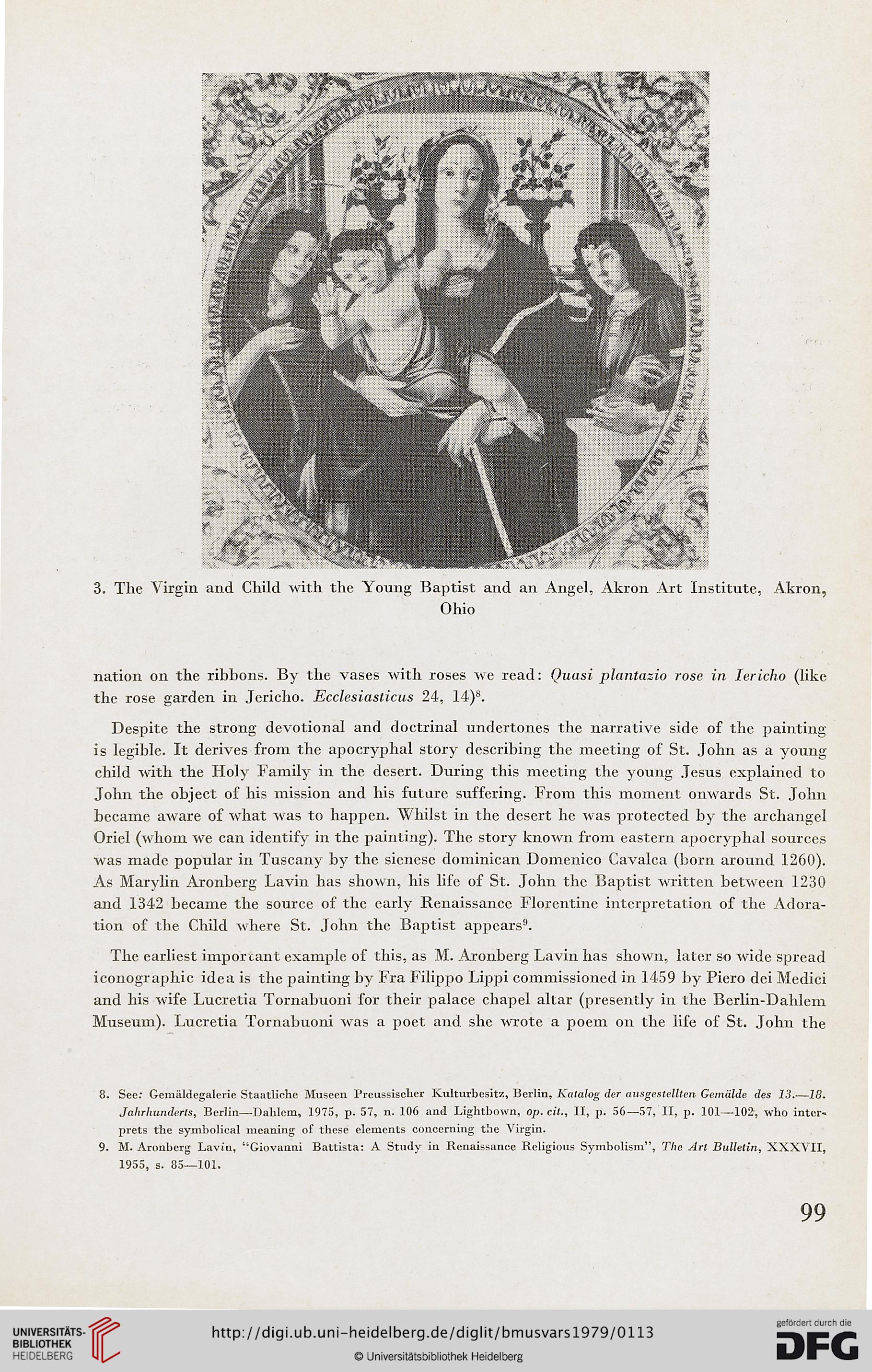nation on the ribbons. By tlie vases with roses we read: Quasi plantazio rose in Iericho (like
the rose garden in Jericho. Ecclesiasticus 24, 14)6.
Despite the strong devotional and doctrinal undertones the narrative side of the painting
is legihle. It derives from the apocryphal story describing the meeting of St. John as a young
child with the Holy Family in the desert. During this meeting the young Jesus explained to
John the object of his mission and his futurę suffering. From this moment onwards St. John
became aware of what was to happen. Whilst in the desert he was protected by the archangel
Oriel (whom we can identify in the painting). The story known from eastern apocryphal sources
was made popular in Tuscany by the sienese dominican Domenico Cavalca (born around 1260).
As Marylin Aronberg Lavin has shown, his life of St. John the Baptist written between 1230
and 1342 became the source of the early Renaissance Florentine interprctation of the Adora-
tion of the Child where St. John the Baptist appears9.
The earliest important example of this, as M. Aronberg Lavin has shown, later so wide spread
iconographic idea is the painting by Fra Filippo Lippi commissioned in 1459 by Piero dei Medici
and his wife Lucretia Tornabuoni for their palące chapel altar (presently in the Berlin-Dahlem
Museum). Lucretia Tornabuoni was a poet and she wrote a poem on the life of St. John the
8. See: Gemaldegalerie Staatliclie Museen Prcussischer Kulturbesitz, Berlin, Katalog der ausgeslellten Gemalde des 13.—18.
Jahrhunderls, Berlin—Dalilem, 1975, p. 57, n. 106 and Lightbown, op. cii., II, p. 56—57, II, p. 101—102, who inter-
prets the symbolical mcaning of thcse elements concerning the Yirgirl.
9. M. Aronberg Lavin, "Giovanni Battista: A Stndy in Renaissance Religions Symbolism", The Art Bulletin, XXXVII,
1955, s. 85—101.
99
the rose garden in Jericho. Ecclesiasticus 24, 14)6.
Despite the strong devotional and doctrinal undertones the narrative side of the painting
is legihle. It derives from the apocryphal story describing the meeting of St. John as a young
child with the Holy Family in the desert. During this meeting the young Jesus explained to
John the object of his mission and his futurę suffering. From this moment onwards St. John
became aware of what was to happen. Whilst in the desert he was protected by the archangel
Oriel (whom we can identify in the painting). The story known from eastern apocryphal sources
was made popular in Tuscany by the sienese dominican Domenico Cavalca (born around 1260).
As Marylin Aronberg Lavin has shown, his life of St. John the Baptist written between 1230
and 1342 became the source of the early Renaissance Florentine interprctation of the Adora-
tion of the Child where St. John the Baptist appears9.
The earliest important example of this, as M. Aronberg Lavin has shown, later so wide spread
iconographic idea is the painting by Fra Filippo Lippi commissioned in 1459 by Piero dei Medici
and his wife Lucretia Tornabuoni for their palące chapel altar (presently in the Berlin-Dahlem
Museum). Lucretia Tornabuoni was a poet and she wrote a poem on the life of St. John the
8. See: Gemaldegalerie Staatliclie Museen Prcussischer Kulturbesitz, Berlin, Katalog der ausgeslellten Gemalde des 13.—18.
Jahrhunderls, Berlin—Dalilem, 1975, p. 57, n. 106 and Lightbown, op. cii., II, p. 56—57, II, p. 101—102, who inter-
prets the symbolical mcaning of thcse elements concerning the Yirgirl.
9. M. Aronberg Lavin, "Giovanni Battista: A Stndy in Renaissance Religions Symbolism", The Art Bulletin, XXXVII,
1955, s. 85—101.
99




